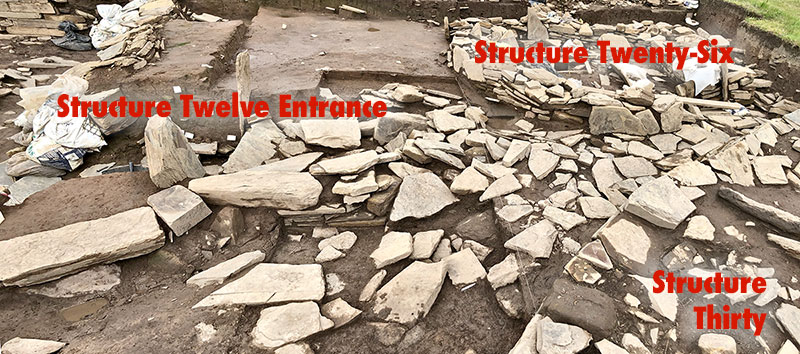A remarkable pottery sherd…
Diary – Tuesday, July 14, 2020
Day Seven

Six years ago today, the six-week 2014 excavation season at the Ness began.
As usual, the first few days involved uncovered and preparing the site, but dig director Nick had big plans for 2014, including:
- Floor deposits: Work began on these in Structures One, Ten and Fourteen in 2013. It was to continue intensively in 2014, using single-context plans and recording, together with mass sampling of deposits using a range of scientific methods.
- In the central midden, the baulks would be removed, allowing the area to be treated as a single entity and perhaps shed more light on the role of the central standing stone.
- In Trench T the plan was to extend and go deeper and see whether it was just an enormous midden mound or whether a structure lay beneath.
- In Structure Twelve, the aim was to reach the primary deposits.
More on all of these in the days to come.

The first artefact today is a remarkable pottery sherd unearthed on this day in 2015.
The sherd came from high in the midden layer and was highly decorated. Incised cordons formed different-sized panels with the rectangular ones left plain. Others, however, including an adjacent triangular panel, filled with decoration that appeared to be fingernail impressions.
The complex impressed decoration stretched right down to the base and was provisionally identified as Late Neolithic Impressed Ware.
Because of its context, it is clearly late in the sequence of the site and was tentatively placed around 2300BC or 2400BC.

Elsewhere on site what appeared to be a hearth was beginning to emerge near the central standing stone.
The feature, which was associated with a stone box, was outside Structure Twelve and thought to relate to its original build and therefore date to around 3200BC.
On Thursday, July 14, 2016, Structure Fourteen was back in the spotlight – or, more accurately, what may lie beneath it.
A few years previously, a sondage (a small, but deep exploratory trench) was inserted under Structure Fourteen’s robbed-out western wall.
Under the earlier building beneath Structure Fourteen, Hugo discovered several sherds of a distinctive and very old ceramic vessel.

It was identified as a modified carinated bowl – a rather coarse version of a finer and more familiar carinated type (“carinated” describes a pottery vessel where the angle of the wall changes. Where the change is located is described as “the carination”).
That round-based bowl was dated to around 3500BC.
In 2016, with the excavation of Structure Fourteen nearing completion, it was decided to have another look. The sondage was increased in size and on this day, four years ago, Hugo began the excavation.
Early finds included an unusual, but rather small, pottery sherd has emerged as well as a number of large pieces of burnt flint.

Over in Structure Ten, Mike had been very carefully revealing the flagstones under the corner buttress (relating to its secondary remodelling). He uncovered a large quantity of shattered pottery under collapsed stones close to a deposit of very large animal bones. The animal remains were articulated (joined) and looked very much like a foundation deposit.
Although we have found a few, flint arrowheads at the Ness remain a rarity. So there was great excitement in the afternoon of July 14, 2016, when one turned up outside Structure Ten.
It was a chisel arrowhead, so called because the business end of the is shaped like a broad chisel rather than a point. This makes it particularly deadly as the broad chisel will cause significant bleeding in its target (animal or human) and bring down the prey quickly.
There were no diggers on site on this day in 2017 and 2018, so it’s straight to 2019.
Although July 14, last year, fell on a weekend, work in previous days had revealed there was clearly something going on outside the eastern entrance to Structure Twelve.

The excavation results suggested there might be a passageway aligned with the entrance, but as the season progressed the picture became more complex. This area under excavation is pictured above, with a key below to identify the surrounding buildings.
It wasn’t long before it became clear that after numerous phases of alterations and additions, a cell-like annexe had been constructed outside this entrance.
Filled with animal bone and examples of incised and cup-marked stone. this annexe was blocked off in later life.
















